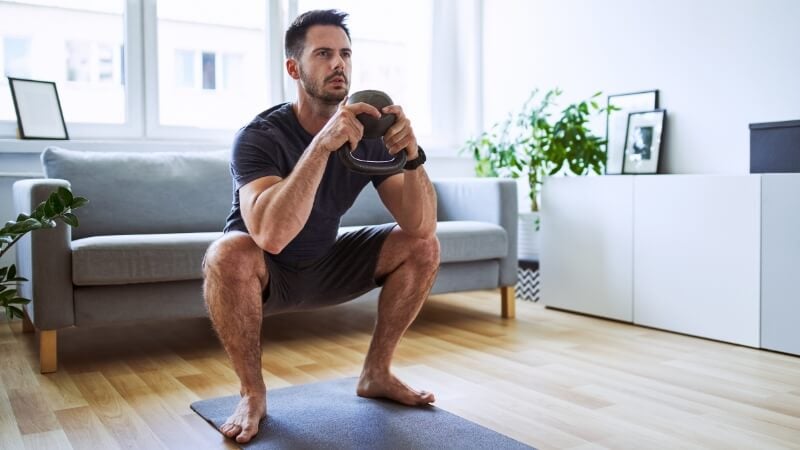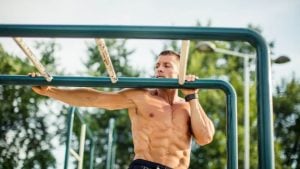The squat is one of the foundational lower body exercises in calisthenics. It's a compound movement that works the entire body including the quads, glutes, and hamstrings as well as the lower back and core muscles.
Squat mobility is necessary for proper squat form
To perform the squat in the best possible form you need squat mobility and you also need to pay attention to some details such as:
- Starting Position: Stand with your feet shoulder-width apart and your toes pointing forward or slightly outward. Keep your chest up, shoulders back, and core engaged.
- Eccentric movement: Begin the movement by bending at your knees and hips, pushing your hips back and down as if you were sitting in a chair. Keep your weight on your heels, and try to keep your knees tracking over your toes.
- Bottom position: Descend until your thighs are parallel to the ground or lower. If you have mobility issues, you may not be able to squat this low, and that's okay. Focus on getting as low as you can without compromising form.
- Knee and chest position: Ensure that your knees are pointing in the same direction as your toes and not caving inwards. Keep your chest up and avoid rounding your lower back.
- Concentric movement: Push through your heels and stand up, keeping your core engaged and your chest up throughout the movement.
- Breathing: Inhale as you squat down and exhale as you stand back up.
Always perform the squat in a controlled manner, don’t drop your weight down but instead resist gravity. Once you have mastered the bodyweight squat with perfect form, you can start to add weight to make the exercise more challenging.
Mobility for squat depth
The proper squat technique requires a good level of flexibility in the hip and ankle joints, more specifically adequate
- dorsiflexion: flexibility in the ankle that allows the foot to move towards the shin
Ankle flexibility is particularly important in squatting as it allows the knees to travel forward without the heels lifting off the ground. Tight ankle muscles or limited ankle mobility can prevent the knees from tracking forward over the toes, leading to compensations such as leaning forward and rounding the lower back.
- hip flexion: flexibility in the hip joint that allows the hip to move forward
Adequate hip mobility allows the pelvis to tilt forward and the thighs to rotate outward, which allows the knees to track over the toes and for the individual to achieve a full range of motion in the squat. Limited hip mobility can result in compensations such as rounding the lower back, which can increase the risk of injury.
The role of ankle mobility for squats
The complexity of the ankle joint lies in its intricate interplay of bones, ligaments, tendons, and muscles, all of which work together to allow it to perform its function.
The ankle joint is a hinge joint that connects the leg to the foot. It is composed of three bones: the tibia, the fibula, and the talus. The tibia and fibula are the two bones of the lower leg, while the talus is one of the bones of the foot.
The ankle joint is also made up of several ligaments and tendons that provide stability and support to the joint. The ligaments include the anterior talofibular ligament, the posterior talofibular ligament, and the calcaneofibular ligament. These ligaments help to prevent excessive movement of the ankle joint in different directions.
In addition, there are several muscles that cross the ankle joint, including the gastrocnemius, soleus, and tibialis anterior. These muscles help to move the ankle joint and provide support to the joint during weight-bearing activities such as squats.
Signs of limited ankle mobility:
- You can’t go below parallel with the ground
- You lean forward too much
- Your heels lift off the ground
During a squat, your body weight shifts back toward your heels as you lower your hips toward the ground. If you have limited ankle mobility or flexibility, it can be challenging to keep your heels on the ground during the squat. This shift in weight requires a stable and balanced base of support from your feet, with the heels remaining in contact with the ground.
If repeated over a longer period of time or if you even add weight it can cause serious lower back injuries.
The role of hip mobility for squats
The hip joint is a ball-and-socket joint that connects the thigh bone (femur) to the pelvis. The hip joint is composed of two main parts: the ball-shaped head of the femur and the cup-shaped socket of the pelvis (acetabulum). The head of the femur sits snugly inside the acetabulum, forming a strong and stable joint. The surfaces of both bones that form the joint are covered in a layer of smooth, slippery cartilage, which allows for smooth and frictionless movement.
Surrounding the hip joint is a capsule of fibrous tissue that helps to hold the bones of the joint in place. This capsule is reinforced by several ligaments that provide additional support and stability to the joint.
There are also several muscles that attach to the bones of the hip joint, including the gluteus maximus, gluteus medius, and iliopsoas muscles. These muscles help to move the hip joint and provide stability and support during movements such as squats.
The hip joint is capable of performing 4 main functions:
- Internal rotation
- External rotation
- Hip flexion
- Hip extension
Internal rotation refers to the rotation of the thigh bone (femur) inward towards the midline of the body, while external rotation refers to the rotation of the thigh bone outward away from the midline of the body.
Hip flexion refers to the movement of the thigh bone upward towards the abdomen, while hip extension refers to the movement of the thigh bone backward away from the body.
Signs of limited hip mobility are:
- Your knees move inwards when you do a squat
- You round your back when lowering your hip into a squat
As you perform a squat, your hips are rotating and your femurs are externally rotating to allow for proper form and alignment. When the knees cave in or move inward, it can cause the femur to internally rotate, which can put stress on the hip joint and surrounding muscles.
Specifically, when the knees move inward during a squat, the hip abductor muscles (such as the gluteus medius) may not be fully engaged, which can cause the hip joint to be unstable. This can increase the risk of injury, such as a strain or tear of the hip abductor muscles or other soft tissues in the hip.
When the knees move extensively inward, it can also put extra pressure on the knee joint, which can increase the risk of injury to the knee
How to increase squat mobility?
Exercises for ankle mobility
- Foot circles - Rotate your foot in a circular motion, starting with small circles and gradually increasing the size of the circles. Make sure you put effort into making full circles. You should feel your shin and calf muscles engaged.
- Toe raises (dorsiflexion) - While standing, put your feet next to each other and lean against the wall or hold onto something. Elevate the toes with your feet towards your shins while the heels stay on the ground.
- Ankle rotations - Assume a lunge position and apply some pressure inside your knee to move it outward. Do it as a dynamic stretch with press and release motion. Repeat with the other leg as well.
- Calf raises - Step on an elevated surface with your heels hanging down. Lift off your heel as high as possible then lower it as low as possible - through the full range of motion.
- Elevated ankle stretches (dorsiflexion) - Place the ball of your foot on an elevated surface and then gently stretch the ankle by pressing on the knee to move it forward. You can do it as a static exercise and hold the maximally stretched position for some time or as a dynamic exercise by pressing on and off the knee. You can also put a kettlebell as weight on top of your knee to apply extra pressure. Make sure your heels don’t lift off.
- Heel elevated squats - Stand in a shoulder-width position, toes pointing slightly outward. Elevate your heels on a platform or weight plates and then perform a squat. This exercise uses less dorsiflexion and makes it possible to perform a squat with limited ankle mobility.
- Goblet squats - This is a variation of a squat where you hold a weight plate or kettlebell in front of you when performing the squat. The weight serves as a counterbalance so people with limited ankle mobility don’t fall back.

Exercises for hip mobility
To prevent knee caving and reduce the risk of injury, it's important to maintain proper squat form and engage the hip abductor muscles throughout the movement. This can be achieved through exercises that help to strengthen the hip abductor muscles and improve hip stability.
- Hip flexor stretch: This stretch helps to improve flexibility in the hip flexor muscles, which can become tight from prolonged sitting or inactivity. To perform the stretch, kneel on one knee with the other foot in front of you, and gently lunge forward until you feel a stretch in the hip flexor of the back leg. Hold for 30 seconds and repeat on the other side.
- Butterfly stretch: This stretch helps to open up the hips and improve flexibility in the groin and inner thighs. Sit on the floor with the soles of your feet touching, and gently press your knees toward the floor while keeping your back straight. Hold for 30 seconds and repeat.
- Pigeon pose: This exercise helps to stretch the hip flexors, outer hip, and glute muscles. Begin on your hands and knees, bring one knee up towards your chest and then place your shin parallel to the front of your mat. Slide your back leg straight back and then lower your torso to rest over your front leg. Hold for 30 seconds and repeat on the other side.
- Fire hydrant: This exercise targets the hip abductor muscles and can help to improve hip stability. Start on all fours and lift one leg out to the side, keeping the knee bent. Lower the leg back down and repeat for 10-15 repetitions, then switch sides.
- Leg swings: This exercise helps to improve hip mobility and increase flexibility in the hip flexors and glute muscles. Stand with one hand on a wall or support, and swing one leg forward and back, keeping the leg straight. Repeat for 10-15 repetitions, then switch sides.
- Cat Camel: Begin on your hands and knees, with your hands directly under your shoulders and your knees directly under your hips. Inhale and arch your back, dropping your belly towards the floor, lifting your head, and looking up towards the ceiling. This is the "cat" position. Exhale and round your spine, tucking your chin to your chest, and contracting your abdominal muscles. This is the "camel" position.
- Clamshells: This exercise targets the hip abductor muscles and can help to improve hip stability. Lie on your side with your knees bent and your feet together. Keeping your feet touching, lift your top knee as high as you can without moving your pelvis. Repeat for 10-15 repetitions, then switch sides.
Squat mobility program
Before you jump into the workout you may want to check out a few tips on how to start calisthenics. Once you are ready to get down to work we've put together a quick squat mobility routine that you can try:
- Warm-up:
- Foot circles: 10 repetitions in each direction
- Toe raises: 10 repetitions
- Calf raises: 10 repetitions
- Elevated ankle stretches: 30 seconds on each side
- Mobility exercises:
- Hip flexor stretch: 30 seconds on each side
- Butterfly stretch: 30 seconds
- Pigeon pose: 30 seconds on each side
- Fire hydrant: 10 repetitions on each side
- Leg swings: 10 repetitions in each direction
- Cat camel: 10 repetitions
- Clamshell: 10 repetitions on each side
- Squat progressions:
- Doorway assisted squats: 10 repetitions
- Heel elevated squats: 10 repetitions
- Goblet squats: 10 repetitions
- Cool-down:
- Butterfly stretch: 30 seconds
- Pigeon pose: 30 seconds each side
- Elevated ankle stretches: 30 seconds each side
Tips:
- Perform the warm-up exercises to prepare your body for the mobility work and squat progressions.
- Do the exercises barefoot or in zero-drop shoes.
- Focus on quality of movement over quantity, and move slowly and smoothly through each exercise.
- Use the doorway assisted squats to gradually progress into deeper squats.
- Progress to more challenging squat variations, such as heel elevated squats and goblet squats, as your mobility improves.
- Remember to cool down and stretch after your workout to prevent stiffness and soreness.




